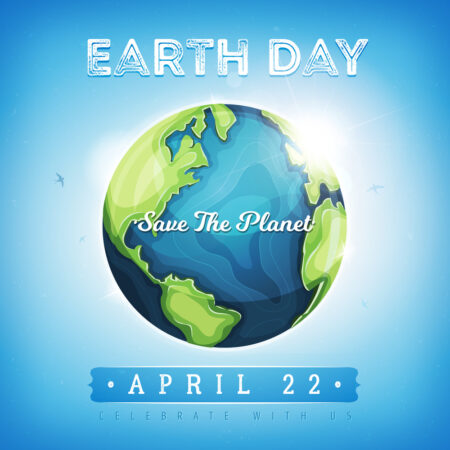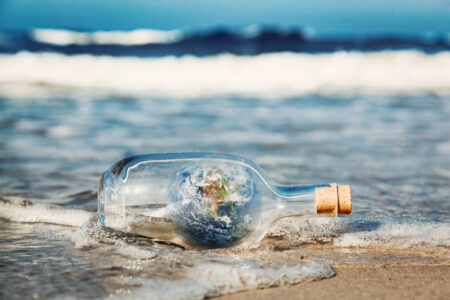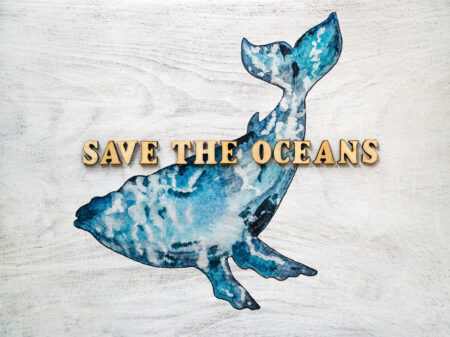MicroPlastic particles are the newest monsters to threaten the civilized world and our planet, even as we celebrate Earth Day. Instead of an organic blob-like creature from outer space, deadly MicroPlastic particles are invading our globe. The news still sounds like Science Fiction. Yet, reputable research scientists are currently warning us that we are eating, breathing, and constantly absorbing micro-particles of plastic. And we of Consolidated Waste Systems want to make sure you are listening to alerts.
MicroPlastic Monster Is Consuming the Earth

Celebrate Earth Day: Find Ways to Help the Earth…Recycle Plastic Bottles…Make a Difference.
The casual listener might think we are saying, “MicroPlastic Monsters Are Consuming the Earth!” This sounds like a bad Science Fiction movie title. However, it’s not a movie or a bad joke. It’s real, as real as National Geographic’s fine research reputation. Credible scientists are now calling Micro-Plastic particles a real threat to the life of the planet.
The MicroPlastic Crisis: A Look to the Future
In our previous blog, we, Consolidated Waste Systems, promised the continuation of the series on the historical development of waste management through the years. This included a description of “Dirty Old England.” However, as we approach Earth Day, 2021, April 20-22, the current microPlastic threat demands the temporary postponement of our historical discussions.
Instead of our past, we must focus on the future with this important blog article. Thus, Consolidated Waste Systems celebrates and commemorates Earth Day 2021 with this blog on the MicroPlastic threat. We hope to spread the understanding that our plastic waste crisis has become a modern monster. And now, we see results of the crisis, MicroPlastic particles threatening human life as they invade our oceans, air, soil, and food sources–our earth.
MicroPlastic Panic Attack?
The alarming news about MicroPlastics deserves caution. We do not want to incite anxiety, and we know that scientists have not yet verified all the facts on MicroPlastics. However, the credence given by established scientific minds warrants serious consideration. And that cautious consideration from the public is the goal of Consolidated Waste Systems Blog this week.
After all, “There often are tiny bits of plastic in the fish and shellfish we eat. Scientists are racing to figure out what that means for our health.”
MicroPlastic Pollutions: Alarming Headlines

Consolidated Waste Systems Ask: Is Your System Part of the Solution? Or Part of the Problem?
The crisis posed by MicroPlastic particles is not limited to just one threat. There are several. And they read like “Newspaper headlines”:
- Ocean Micro-Plastic Particles Reaching Critical Levels.
- Atmosphere polluted by deadly MicroPlastic particles.
- Plastic in Local Rivers and Streams Threaten wildlife and Human Health.
- Safe Food and Water Supply Threatened by Plastic Soil Saturation.
But, wait! The above headlines do not have to happen. Right now, they are just speculation. Scientists have not yet determined how severe the effects of MicroPlastics will be. Perhaps it is not too late to control our plastic waste crisis and tame the MicroPlastic monster. Let us try to separate our fears from our facts as we examine the threats of MicroPlastic Particles.
What Are MicroPlastic Particles?
On the basic level, we already know the term Micro means very small. The Webster Dictionary defines it as “ a very small particle especially: one that is microscopic in size.
Now, National Geographic scientists describe MicroPlastic particles in a very specific scientific manner.
- The experts state, “Microplastics are tiny plastic particles that result from both commercial product development and the breakdown of larger plastics. As a pollutant, microplastics can be harmful to the environment and animal health.”
- Additionally, the National Geographic scientists sharpen the MicroPlastic Particle definition. They state these plastic pieces, nodules, beads, and filaments are “less than five millimeters (0.2 inches) in diameter.”
- These are such tiny pieces of plastic that water fleas mistake them for food. The little creatures bloat and deform from ingesting the plastic. The creatures are crippled. They live–but not well. Then bigger fish eat them. And ultimately, we eat the bigger fish. Scientists are trying to discover just how much that harms the human body.
MicroPlastic, The Shape-Shifting, Multi-Environmental Enemy
These minuscule bits of plastic not only infiltrate our oceans and freshwater but also our air and soil. And, as we have said previously, the contaminating particles are not just the result of consumer waste management. You see, manufacturers must own some of the guilt. Manufacturers create light plastic dust as part of the process of plastic creation to serve our society.
Thus, factories can not prevent MicroPlastic Particles from floating on the wind. Likewise, these particles are born from the disintegration of larger pieces of stored, used, or trashed plastic. Likewise, the Micro-Plastic pieces can disintegrate from larger pieces of plastic.
Micro-Plastic Disintegration Situation: A Real Life Example of Plastic Break-Down

Earth Day Message: Your Waste Systems Help Businesses Save the Planet.
This writer has personally experienced an obvious case of plastic disintegration. In many situations, disintegration the first step in the life cycle of microPlastic. Take a look at my moment-of-truth story.
I received a toolbox as a Christmas present approximately 10 years ago. I remember thinking “What a strong sturdy box. It should last the rest of my life.” And the name on the box was one that had the reputation for strength and durability. This was a backup box of tools, extras for my collection. And I neglected it, as we sometimes do with cute gifts.
The toolbox languished in the garage for a decade. Then, recently, even as I did my research for this article, I re-discovered the impressive little box. It was beautiful. In fact, it still looked brand new. However, when I tried to open it, the plastic crumbled in my hand. You cannot imagine my horror as large, medium, and tiny bits of microplastic sifted through my fingers and crashed to the ground.
And that is what happens to most plastics, whether they are stored in a garage, buried in a landfill, or dumped in the ocean. Eventually, most of them disintegrate, but they do not decay in the natural, organic way.
And finally, the plastic particles become so small, they can literally float in the air or semi-dissolve in the water. Of course, some plastics may take a thousand years to complete this process.
The Big Question: How Do These Tiny Pieces Become Fearful Monsters?
The sheer quantity of plastics produced is staggering.
- You may recall from an earlier Consolidated Waste System’s Blog that 3,000,000 tons of plastic waste products were produced in 2018.
- Many types of plastics have a very limited life cycle which means a tremendous amount of waste. This coupled with a recycling rate of only 8.7 percent almost guarantees a lack of recycling. Wouldn’t it be more efficient to stop creating it?
Earlier in this blog, we mentioned several areas of concern. Our quest to analyze concentrations of MicroPlastic in our world extends first to our atmosphere and the ocean. Beyond those concerns, we are keeping watch over rivers, streams, and finally, our food supply. Let’s examine what scientists are saying about each area of the MicroPlastic invasion.
Dangers of Atmospheric Concentrations

This Whale Eats Plankton…Plastic Looks Like Plankton.
Can you visualize breathing plastic particles? The claims that plastic is airborne means that some of your worst fears could be realized.
Many scientists believe that airborne plastic is the only explanation for the quantity of Micro-plastic particles finding their way into remote areas of the world.
The publication, Science Direct has reported on studies of Microplastics (MP) that included Micro-Plastics in various environments.
Recently, microplastics have been observed in atmospheric fallout collected from some cities. “Although the studies are limited, some researches have shown that synthetic textiles are the main source of airborne microplastics, and fibers are the dominant shape of microplastics in the atmosphere.”
- Due to their small size, airborne Microplastics (MPs) can be directly inhaled posing health risks to humans.”
- Wind can transport MPs through the atmosphere over a long distance.
- Meteorological conditions and human activities affect the concentration and deposition of microplastics.
Caution, Breathing MicroPlastic Could be Hazardous to Your Health
The inhalation of MicroPlastics could pose possible serious health risks to humans. Additionally, our food supply, including cattle, poultry, etc., could be threatened. And again, we are already seeing the effects of the MicroPlastic particles on wildlife as well as our personal pets.
Atmospheric MicroPlastic Particles: Premature Speculations?
The answer to this question is, we simply don’t know. There is so much that we still have to learn. Much research is needed to make definite determinations.
Complicating this is the recent discovery of NanoPlastic particles, even smaller than MicroPlastic particles. We have re-created them in the laboratory. These particles are so tiny they can actually invade animal life including humans. “The researchers mentioned that they still do not know if these plastic components are hazardous to human health; however, the fact that plastic waste materials can invade the human system and accumulate in various tissues and organs is itself very alarming.”
Coming, Part 2: Threats Involving the Ocean, Fresh Water, and Food Supply

MicroPlastics in the Ocean Can Suffocate You Faster Than You Can Drown.
MicroPlastic particles threaten all forms of life in the sea from algae to the fish we eat. Additionally, our streams (drinking water) and food supply are involved.
Our next blog, Part 2, covers both of these additional concerns. Thanks for reading the Consolidated Waste Systems Blog.
And we close with this quote in honor of Earth Day, spoken by Evo Morales.


